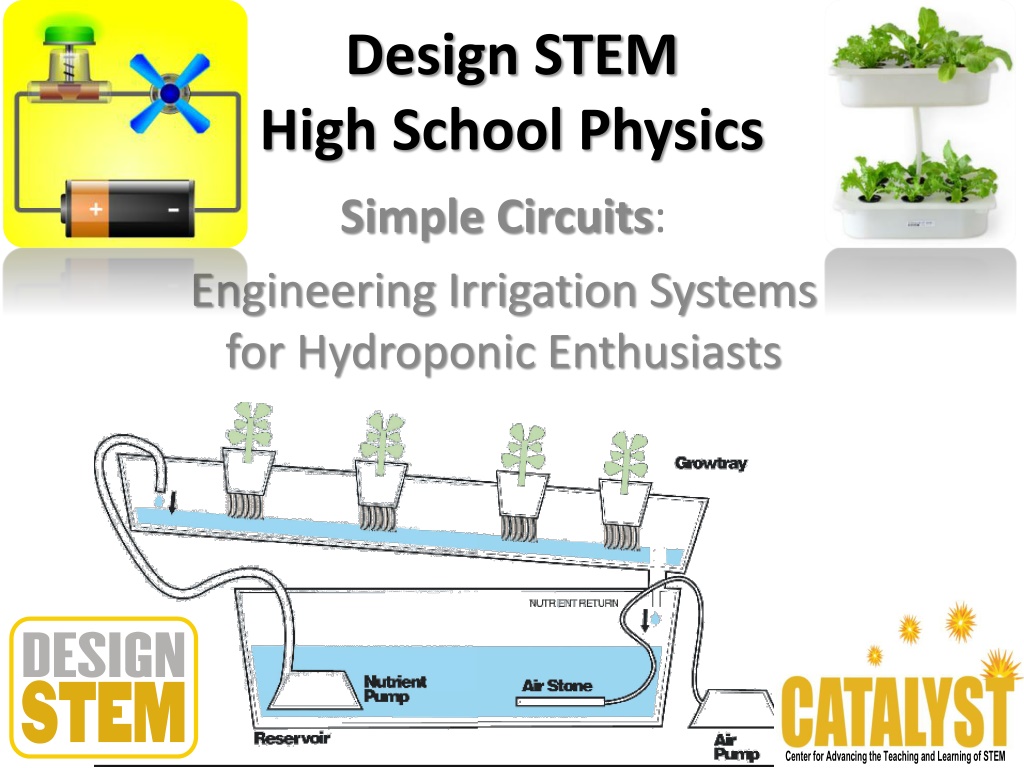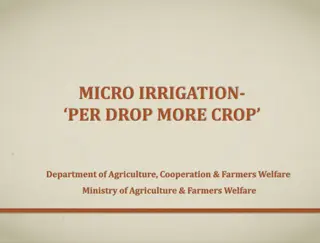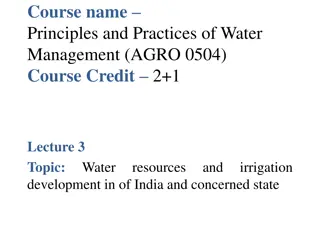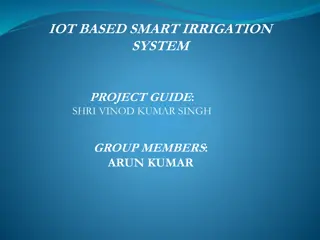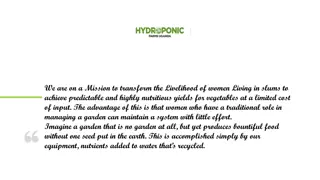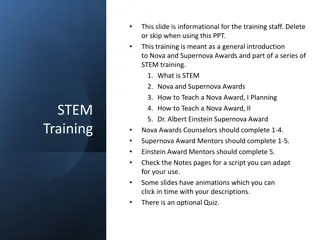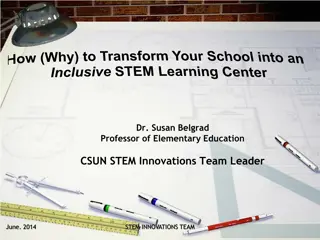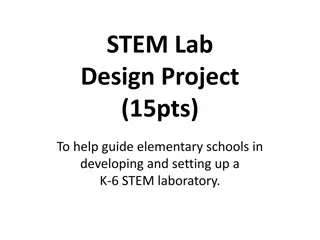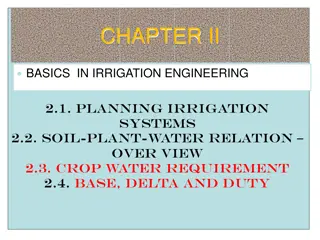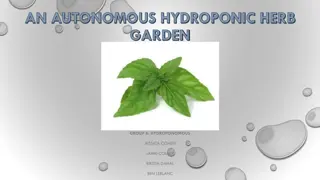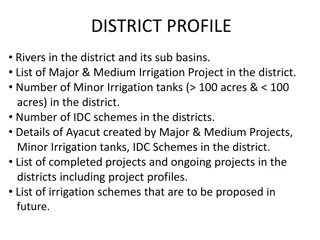Designing STEM High School Physics: Engineering Irrigation Systems for Hydroponic Enthusiasts
Explore a hands-on workshop in high school physics focusing on simple circuits, series, and parallel circuits, with a practical application in designing irrigation systems for hydroponic enthusiasts. Dive into concepts like water pumps, variable resistors, and circuit design challenges. Enhance understanding of voltage, current, and resistance while meeting the specific needs of off-grid hydroponic farmers. Get ready to engineer solutions and empower hydroponic enthusiasts through user-friendly manuals for customizable water flow rates and delivery heights.
Download Presentation

Please find below an Image/Link to download the presentation.
The content on the website is provided AS IS for your information and personal use only. It may not be sold, licensed, or shared on other websites without obtaining consent from the author. Download presentation by click this link. If you encounter any issues during the download, it is possible that the publisher has removed the file from their server.
E N D
Presentation Transcript
Design STEM High School Physics Simple Circuits: Engineering Irrigation Systems for Hydroponic Enthusiasts ? Center for Advancing the Teaching and Learning of STEM
Agenda For Today 8:30 AM Introduction Lesson 1 : What is a Water Pump? Lesson 2 : Series & Parallel Circuits Break Lesson 3 (Optional): Voltage, Current, and Resistance in Series & Parallel Circuits Lunch Lesson 4 : What is a Variable Resistor? Lesson 5 : Design Challenge Creating a Water Pump Circuit Wrap up 12:00 PM 3:15 PM ? 2 Center for Advancing the Teaching and Learning of STEM
Before We Begin Prerequisites (if used in HS Physics class): Understand what a complete circuit is, Know how to light a bulb with one battery and wire, Be able to identify simple circuit elements, and Be familiar with Ohm s law. ? 3 Center for Advancing the Teaching and Learning of STEM
Before We Begin Indiana State Content Standards ? 4 Center for Advancing the Teaching and Learning of STEM
Before We Begin Also What is Engineering Design? What is Inquiry? What, if any, is the interplay between Engineering Design and Inquiry? ? 5 Center for Advancing the Teaching and Learning of STEM
Hydroponic Systems https://www.youtube.com/watch?v=6kUm_I7bLYw https://www.youtube.com/watch?v=Rj4MzjxjGck https://www.youtube.com/watch?v=EJjAWF2DfWY https://www.youtube.com/watch?v=aJorITEWCWk ? 6 Center for Advancing the Teaching and Learning of STEM
The Challenge You are working as an engineer for a company that manufactures irrigation systems for hydroponic farmers. Recently, your company has begun to meet the specific needs of home hydroponic enthusiasts that are remotely located i.e. they are not accessible to any electrical power grid. You and your team are tasked with the challenge to produce an electrical pumping system i.e. the pump along with the electrical circuit and power source that drives the pump to serve the needs of such hydroponic enthusiasts. Further, you are also asked to produce a user s manual for hydroponic enthusiasts that would enable them to use the system for their specific criteria and constraints, such that the water flow rate and height of water delivery can be adjustable for multiple hydroponic plan configurations. ? 7 Center for Advancing the Teaching and Learning of STEM
Lesson 1 : What is a Water Pump? Questions for Guiding Engineering Design What is the problem? Who is your end-user in this story? What are the needs of your end-user? What info do you need to solve this problem? What are possible design considerations? Others? ? 8 Center for Advancing the Teaching and Learning of STEM
Lesson 1 : What is a Water Pump? Questions for Guiding Inquiry Have you ever wondered how to move water up to a certain height? Have you ever wondered how water can be removed from flooded basements? What is a water pump? How do you think a water pump works? What might you need to get a water pump to work? Can you find a way to run a water pump using a battery and be able to adjust its flow rate? ? 9 Center for Advancing the Teaching and Learning of STEM
Lesson 1 : What is a Water Pump? Examples of Water Pumps https://www.youtube.com/watch?v=2hP5ZKZfO1Q https://www.youtube.com/watch?v=OBp8-WWhxJU https://www.youtube.com/watch?v=mP8_RAt75bQ https://www.youtube.com/watch?v=BaEHVpKc-1Q ? 10 Center for Advancing the Teaching and Learning of STEM
Lesson 1 : What is a Water Pump? Where are pumps used? https://www.youtube.com/watch?v=x21kClCjkW0 https://www.youtube.com/watch?v=D9Ukbklc6gc https://www.youtube.com/watch?v=48jNBQboYt4 ? 11 Center for Advancing the Teaching and Learning of STEM
Lesson 2 : Simple Circuits Questions for Guiding Inquiry Can you find a way to connect the battery, light bulbs, and wires to make the bulbs appear dim when lit? Can you find a way to connect the battery, light bulbs, and wires, to make the bulbs appear bright when lit? ? 12 Center for Advancing the Teaching and Learning of STEM
Lesson 2 : Simple Circuits Questions for Guiding Design Why do the light bulbs appear to be bright in some ways and dim in others? How could you use this feedback to inform your design of connecting a water pump to a battery in Lesson 1? ? 13 Center for Advancing the Teaching and Learning of STEM
Lesson 2 : Simple Circuits Useful Interactive Simulations https://phet.colorado.edu/en/simulation/legacy/circuit- construction-kit-dc https://phet.colorado.edu/en/simulation/legacy/circuit- construction-kit-dc-virtual-lab ? 14 Center for Advancing the Teaching and Learning of STEM
Lesson 3 : Current & Voltage in Simple Circuits OPTIONAL Questions for Guiding Inquiry How do the current and voltage compare across different resistors that are in series? In parallel? How does the combined resistance change when two resistors are added in series? in parallel? ? 15 Center for Advancing the Teaching and Learning of STEM
Lesson 4 : What is a Variable Resistor? Questions for Guiding Inquiry What is a variable resistor and how can you change its resistance? What happens when a variable resistor is used in a series circuit? In a parallel circuit? ? 16 Center for Advancing the Teaching and Learning of STEM
Lesson 4 : What is a Variable Resistor? Questions for Guiding Inquiry What is a variable resistor and how can you change its resistance? What happens when a variable resistor is used in a series circuit? In a parallel circuit? ? 17 Center for Advancing the Teaching and Learning of STEM
Lesson 4 : What is a Variable Resistor? Question for Guiding Design How can a variable resistor be used to control the brightness of a bulb in a circuit? Think of more than one way to do this. What ideas that you had learned from series and parallel circuits can be used in your design process? ? 18 Center for Advancing the Teaching and Learning of STEM
Lesson 5 : Design Challenge Creating a Water Pump Circuit Questions for Guiding Inquiry How can you measure the flow rate and head of the pump using the materials provided? How can you measure the relationship between the flow rate and the head? ? 19 Center for Advancing the Teaching and Learning of STEM
Lesson 5 : Design Challenge Creating a Water Pump Circuit Questions for Guiding Design How can you control the flow rate and head of the pump using the materials provided? Think of more than one way to do this. What ideas that you learned from controlling the brightness of the resistor can be used in your design process? ? 20 Center for Advancing the Teaching and Learning of STEM
Lesson 5 : Design Challenge Creating a Water Pump Circuit A Manual for Hydroponic Farmer to Use your Design A diagram showing the submerged pump and how it supplies water to the plant bed above it. The head and flow rate should be labeled and defined for the end user as two important parameters. Circuit schematics showing how the variable resistor, battery and pump are connected together. A paragraph explaining the circuit schematics and how it works to control the flow rate and head by changing the variable resistor. A paragraph explaining the graph of flow rate vs. head for different settings of the variable resistor. The paragraph should also explain to the end user, with a concrete example of how they should fine tune the electrical circuit to achieve a particular desired flow rate and head based on the graph. ? 21 Center for Advancing the Teaching and Learning of STEM
Thank You Power Point slides will be posted on the Blackboard website for the course. If you have any questions regarding this unit, please feel free to contact Sanjay Rebello (rebellos@purdue.edu ) ? 22 Center for Advancing the Teaching and Learning of STEM
